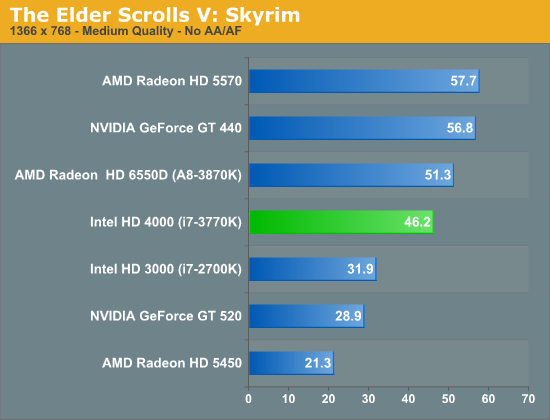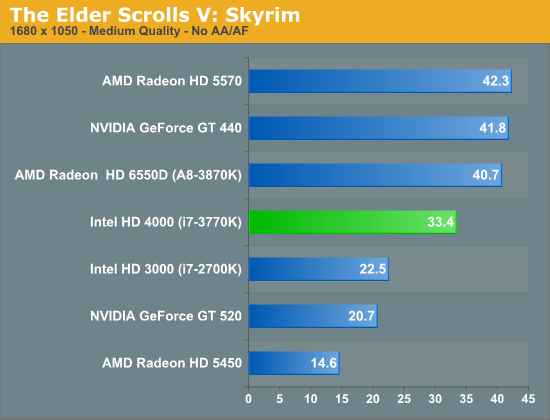The Intel Ivy Bridge (Core i7 3770K) Review
by Anand Lal Shimpi & Ryan Smith on April 23, 2012 12:03 PM EST- Posted in
- CPUs
- Intel
- Ivy Bridge
Bethesda's epic sword & magic game The Elder Scrolls V: Skyrim is our RPG of choice for benchmarking. It's altogether a good CPU benchmark thanks to its complex scripting and AI, but it also can end up pushing a large number of fairly complex models and effects at once. This is a DX9 game so it isn't utilizing any of IVB's new DX11 functionality, but it can still be a demanding game.


Ivy Bridge does very well in Skyrim, not able to reach 60 fps but still above 30 at up to 1680 x 1050. The gains over Sandy Bridge are significant at nearly 50%. Meanwhile Ivy Bridge also gets surprisingly close to Llano, bringing the gap down to 10% at 1366 and 18% at 1680. Seeing as how Skyrim is not particularly shader heavy at these settings, Ivy Bridge looks to be largely shrugging off its biggest bottleneck here in favor of pure pixel pushing power.










173 Comments
View All Comments
DanNeely - Monday, April 23, 2012 - link
Isn't the net OC performance roughly a wash? You're losing ~10% off the top in clock speed, but getting it back by the CPU doing ~10% more per clock.I'm curious what the power gap for the OCed IB is vs SB. For a system kept running at full load, the stock power gap would give a decent amount of yearly savings on the utility bills. If the gap opens even more under OC it'd be a decent upgrade for anyone running CPU farms.
Shadow_k - Monday, April 23, 2012 - link
Very nice igp improvementsAn also when will anandtech do a review on the i5 3570k because igp is underclocked
Ram21 - Monday, April 23, 2012 - link
UltraoboksRam21 - Monday, April 23, 2012 - link
Page 11 has the incorrect title or chart of Starcraft II - GPU Bench on the Dirt 3 pageAnand Lal Shimpi - Monday, April 23, 2012 - link
Fixed both of these, thank you!ltcommanderdata - Monday, April 23, 2012 - link
I don't have a comment on this Ivy Bridge review itself since it's thorough as always from Anandtech and Ivy Bridge seems pretty much what was expected. I do want to suggest a new benchmark for the eventual OpenCL followup when Intel releases new GPU drivers. As AMD mentioned as part of heir HD7000 series launches, WinZip 16.5 has finally been released with OpenCL acceleration in collaboration with AMD. Since fluid simulations won't be a common use case for most consumers and video encoding seems better suited to fixed function hardware like QuickSync, this OpenCL accelerated file compression/decompression will probably be the first and most popular use of GPGPU by consumers. It'll be interesting to see how much of a benefit GPU acceleration brings and whether AMD's collaboration results in better performance from AMD GPUs compared to Intel and nVidia GPUs then raw hardware specs would suggest. Other interesting tests would be to see if the acceleration is more pronounced with 1x1GB compressed file versus many compressed files adding up to 1GB. How well acceleration scales with between different GPU performance classes and whether it'll be bottlenecked by PCIe bandwidth, CPU setup time, system memory transfers or more likely HDD I/O. Whether tightly coupled CPU/GPUs like Llano and Ivy Bridge gives a performance advantage compared to otherwise similar specced discrete GPUs. Whether GPU acceleration is worthwhile on older GPU generations like the AMD HD5000/6000 and nVidia 8000/9000/100/200 series which aren't as compute optimized as the latest AMD HD7000 and nVidia 400/500 series. Whether WinZip 16.5 supports the HD4000 series which is OpenCL 1.0 or whether it requires OpenCL 1.1. Does WinZip 16.5 use OpenCL to help improve performance scaling on high core count CPUs (such as 8 or more cores).If GPU accelerated file compression/decompression is effective hopefully Microsoft and Apple will consider adding it to their native OS .zip handler.
Ryan Smith - Monday, April 23, 2012 - link
Rest assured it's on our list of things to look at, though I haven't seen it yet.mgoldshteyn - Monday, April 23, 2012 - link
The graphics engine still cannot support 10-bit per color IPS displays, as can be found on quality modern laptops from Dell and HP. That means that one is forced to get an overpriced mobile video card from ATI or NVidia to compensate, lowering the laptops power on hours by requiring an external card to be used with these displays. On non-IPS displays, one can choose to use the Intel built in graphics engine to save battery life. No such choice on high quality IPS displays since they are incompatible with the graphics engine of even Ivy Bridge.zaccun - Monday, April 23, 2012 - link
The workstation class laptops you are referring to are only offered with discrete graphics cards. No other machine has a 10 bit IPS panel. There is zero sense in dell or HP offering a machine aimed at professionals doing 3d modeling/CAD/video editing/etc without also putting the graphics horsepower in the laptop to support it.While I personally would love the option of getting a machine with the awesome panels that those notebooks use, without also paying for the $$$$ quadro cards that pros need, neither Dell nor HP offer anything like that.
Arnulf - Tuesday, April 24, 2012 - link
Neither can you eyes distinguish 1 073 741 824 different colors so why would you care ?